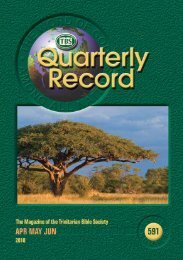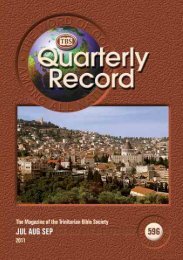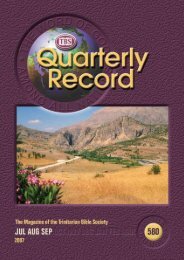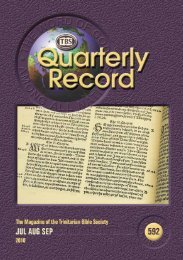Click to Download Document [pdf] - Trinitarian Bible Society
Click to Download Document [pdf] - Trinitarian Bible Society
Click to Download Document [pdf] - Trinitarian Bible Society
- No tags were found...
Create successful ePaper yourself
Turn your PDF publications into a flip-book with our unique Google optimized e-Paper software.
<strong>Trinitarian</strong> <strong>Bible</strong> <strong>Society</strong> – Quarterly Record<strong>Bible</strong> transla<strong>to</strong>rs <strong>to</strong> master all the Semiticlanguages, amazing as it is, was in parthelped by the family similarities behindthe different scripts. The Arabic alphabetis written from right <strong>to</strong> left, like most otherSemitic languages, 8 and shares the cus<strong>to</strong>min writing of having consonants only, withsmaller indications of vowel sounds anoptional extra. There are now several stylesof script: Naskh is used in print and bycomputers, and Ruq’ah is commonly used inhandwriting.Every Arab country makes its owncontribution <strong>to</strong> a rich mix, sharing acommon Arab culture in most aspects.it referred <strong>to</strong> the whole peninsula. TheGreeks and the Romans were familiar withthe region.The pre-Islamic times of Arabian his<strong>to</strong>ryare now referred <strong>to</strong> by Muslim scholarsas Al Jahiliyah—‘the time of ignorance’.Herodotus (425–485 BC) in The His<strong>to</strong>riesrefers <strong>to</strong> the influence of the Arabiansin the 6th century BC extendingthroughout Assyria (modern Iraq). Theytraded in frankincense, myrrh, cassia andcinnamon with Greece, and paid tributeof frankincense <strong>to</strong> King Darius. In the 1stcentury AD following the conquest ofEgypt, Rome began trading directly withMiskan/FlickrGillmore/FlickrExamples of decorative Arabic calligraphyToday most Arabs are Muslim, but Arabidentity is defined independent of religion,and well predates the rise of Islam, withhis<strong>to</strong>rically attested Arab-Christiankingdoms and Arab-Jewish tribes. However,non-Arab people account for over eightyper cent of the world’s Muslim population:not part of the ‘Arab world’, but of thegeographically larger, more diverse ‘Muslimworld’. For them, Arabic is, at the veryleast, a familiar second language, as Latinwas in medieval ‘Christendom’. In terms of<strong>Bible</strong> need and provision we should think,perhaps, of the ‘Arabic-aware’ world.k Some His<strong>to</strong>ryArabia, as a name, was anciently applied <strong>to</strong>the desert region from the east of the NileDelta and round <strong>to</strong>ward Syria; subsequently24Arabia, dramatically redrawing the old‘incense routes’.There were numerous tribes of heathenArabian origin who had willingly, withoutcoercion, converted <strong>to</strong> the religion of theJews (Mosaic faith), or later <strong>to</strong> Christianity,or who became Hanifs: believers in the Godof Abraham. Contact between Hebrewsand Arabs was continuous throughout theirhis<strong>to</strong>ries. Jews probably moved amongthe Arabs as merchant traders, and suchmigrations grew during the Greek andRoman occupations of Judea, especiallyafter the destruction of the Temple ofSolomon in AD 70 and the later JewishRevolt of AD 135.By the time of Muhammad in AD 620,there were numerous and very prosperous


![Click to Download Document [pdf] - Trinitarian Bible Society](https://img.yumpu.com/40894484/26/500x640/click-to-download-document-pdf-trinitarian-bible-society.jpg)


![The Love of the Truth [pdf] - Trinitarian Bible Society](https://img.yumpu.com/49788277/1/184x260/the-love-of-the-truth-pdf-trinitarian-bible-society.jpg?quality=85)
![Bible Word List and Reading Plan [pdf] - Trinitarian Bible Society](https://img.yumpu.com/46882563/1/177x260/bible-word-list-and-reading-plan-pdf-trinitarian-bible-society.jpg?quality=85)
![Click to Download Document [pdf] - Trinitarian Bible Society](https://img.yumpu.com/44904205/1/184x260/click-to-download-document-pdf-trinitarian-bible-society.jpg?quality=85)
![Download Document [pdf] - Trinitarian Bible Society](https://img.yumpu.com/44584740/1/184x260/download-document-pdf-trinitarian-bible-society.jpg?quality=85)



![Download Document [pdf] - Trinitarian Bible Society](https://img.yumpu.com/41007786/1/184x260/download-document-pdf-trinitarian-bible-society.jpg?quality=85)


![Download Document [pdf] - Trinitarian Bible Society](https://img.yumpu.com/39425868/1/184x260/download-document-pdf-trinitarian-bible-society.jpg?quality=85)
![Download Document [pdf] - Trinitarian Bible Society](https://img.yumpu.com/39425821/1/184x260/download-document-pdf-trinitarian-bible-society.jpg?quality=85)